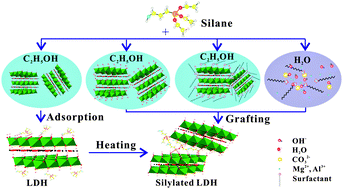Silylation of layered double hydroxidesvia an induced hydrolysis method†
Abstract
A series of layered double

* Corresponding authors
a
Key Laboratory of Mineralogy and Metallogeny, Guangzhou Institute of Geochemistry, Chinese Academy of Sciences, Guangzhou, P. R. China
E-mail:
hehp@gig.ac.cn
b
Chemistry Discipline, Faculty of Science and Technology, Queensland University of Technology, Brisbane, Queensland, Australia
E-mail:
r.frost@qut.edu.au
A series of layered double

 Please wait while we load your content...
Something went wrong. Try again?
Please wait while we load your content...
Something went wrong. Try again?
Q. Tao, J. Zhu, R. M. Wellard, T. E. Bostrom, R. L. Frost, P. Yuan and H. He, J. Mater. Chem., 2011, 21, 10711 DOI: 10.1039/C1JM10328H
To request permission to reproduce material from this article, please go to the Copyright Clearance Center request page.
If you are an author contributing to an RSC publication, you do not need to request permission provided correct acknowledgement is given.
If you are the author of this article, you do not need to request permission to reproduce figures and diagrams provided correct acknowledgement is given. If you want to reproduce the whole article in a third-party publication (excluding your thesis/dissertation for which permission is not required) please go to the Copyright Clearance Center request page.
Read more about how to correctly acknowledge RSC content.
 Fetching data from CrossRef.
Fetching data from CrossRef.
This may take some time to load.
Loading related content
